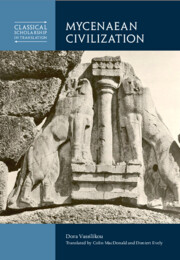Refine search
Actions for selected content:
510 results
6 - Writing
-
- Book:
- Mycenaean Civilization
- Published online:
- 19 December 2025
- Print publication:
- 15 January 2026, pp 474-487
-
- Chapter
- Export citation
10 - Mycenaean Greece in Homer
-
- Book:
- Mycenaean Civilization
- Published online:
- 19 December 2025
- Print publication:
- 15 January 2026, pp 566-579
-
- Chapter
- Export citation
9 - The End of Mycenaean Civilization
-
- Book:
- Mycenaean Civilization
- Published online:
- 19 December 2025
- Print publication:
- 15 January 2026, pp 539-565
-
- Chapter
- Export citation
23 - Marcus Aper and the Ala Apriana
- from Part IV - Juridical and Historical Insights
-
-
- Book:
- Latin Texts on Papyrus and the Study of Classics
- Published online:
- 12 December 2025
- Print publication:
- 08 January 2026, pp 386-395
-
- Chapter
- Export citation
9 - Can the MENA Region Build Its Indigenous Start-Up Unicorns? Analysis of Unicorns and Soonicorns and the Supporting Entrepreneurship Ecosystem
-
-
- Book:
- Unicorns from Emerging Economies
- Published online:
- 05 December 2025
- Print publication:
- 08 January 2026, pp 245-281
-
- Chapter
- Export citation

Mycenaean Civilization
-
- Published online:
- 19 December 2025
- Print publication:
- 15 January 2026
8 - Regulatory Reform to Unlock the Potential of the Arab Third Sector
- from Part II - Capacity Building
-
-
- Book:
- Catalytic Capital
- Published online:
- 27 November 2025
- Print publication:
- 11 December 2025, pp 171-188
-
- Chapter
-
- You have access
- Open access
- HTML
- Export citation
5 - The Application of Ibn ʿAbd al-Salām’s Legal Philosophy in Damascus and Egypt
-
- Book:
- An Islamic Legal Philosophy
- Published online:
- 19 November 2025
- Print publication:
- 27 November 2025, pp 168-202
-
- Chapter
- Export citation
8 - Conclusion: Implications for North Africa and Beyond
-
- Book:
- Labor Unions and Democratic Unrest in North Africa
- Published online:
- 20 November 2025
- Print publication:
- 20 November 2025, pp 295-320
-
- Chapter
- Export citation
Chapter 9 - Print Culture and New Fictional Imagination in Colonial Egypt
- from Part II - Readers and Audiences
-
-
- Book:
- African Literature in Transition
- Published online:
- 23 October 2025
- Print publication:
- 06 November 2025, pp 184-201
-
- Chapter
- Export citation
An Unlimited Supply of Labor? Counting Workers and Planning Development in Mid-Twentieth-Century Egypt (1939–1960)
-
- Journal:
- International Labor and Working-Class History , First View
- Published online by Cambridge University Press:
- 03 November 2025, pp. 1-17
-
- Article
-
- You have access
- Open access
- HTML
- Export citation
New evidence from the late Predynastic to Late Period cemetery at Tarkhan, Egypt
-
- Journal:
- Antiquity , First View
- Published online by Cambridge University Press:
- 03 November 2025, pp. 1-8
-
- Article
-
- You have access
- Open access
- HTML
- Export citation
Portrait of a Martyr as a Young Man: Social Lives of Photographs in Revolutionary Egypt
-
- Journal:
- Comparative Studies in Society and History , First View
- Published online by Cambridge University Press:
- 24 October 2025, pp. 1-34
-
- Article
-
- You have access
- Open access
- HTML
- Export citation
8 - Conclusion
-
- Book:
- Return of Tyranny
- Published online:
- 17 September 2025
- Print publication:
- 23 October 2025, pp 234-248
-
- Chapter
- Export citation
6 - A Popular Mobilization and Egypt’s Counterrevolution
-
- Book:
- Return of Tyranny
- Published online:
- 17 September 2025
- Print publication:
- 23 October 2025, pp 170-202
-
- Chapter
- Export citation
5 - Political Elites and Egypt’s Counterrevolution
-
- Book:
- Return of Tyranny
- Published online:
- 17 September 2025
- Print publication:
- 23 October 2025, pp 118-169
-
- Chapter
- Export citation
1 - Introduction
-
- Book:
- Return of Tyranny
- Published online:
- 17 September 2025
- Print publication:
- 23 October 2025, pp 1-17
-
- Chapter
- Export citation
3 - You Can’t Get There from Here
-
-
- Book:
- Palmyra, the Mediterranean and Beyond
- Published online:
- 21 October 2025
- Print publication:
- 16 October 2025, pp 33-48
-
- Chapter
- Export citation
8 - Channels of Communication and Connections of Style
-
-
- Book:
- Palmyra, the Mediterranean and Beyond
- Published online:
- 21 October 2025
- Print publication:
- 16 October 2025, pp 167-186
-
- Chapter
- Export citation
Chapter 2 - Leadership in Rural Pharaonic Egypt
-
-
- Book:
- Leadership in the Ancient World
- Published online:
- 14 September 2025
- Print publication:
- 16 October 2025, pp 34-57
-
- Chapter
- Export citation
